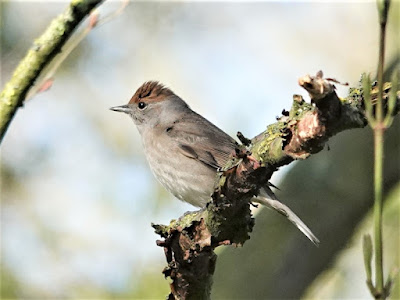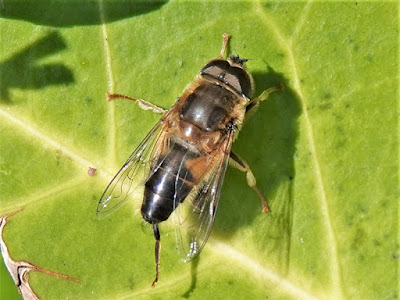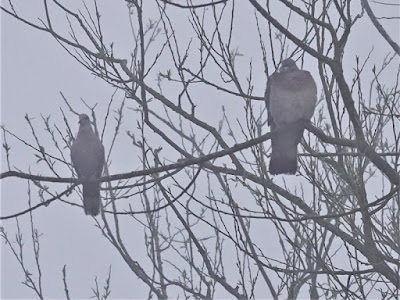3.0°C > 10.0°C: Yet another mixed morning. Clear when I arrived. Low cloud soon streamed in from the south-east, lowering to mist. This lifted after 07:30 and then began to break with good sunny spells after 08:30. Light southerly wind. Very good visibility but poor or very poor in mist.
Sunrise: 05:48 GMT
Priorslee Balancing Lake: 05:00 – 06:25 // 07:15 – 09:50
(68th visit of the year)
Bird notes:
- a pair of Gadwall was flushed out of the West end reeds by fighting Coots and flew off.
Counts of birds noted flying over:
- 22 Canada Geese: two pairs outbound; groups of seven and 11 flew North.
- 2 Greylag Geese: pair inbound
- 2 Mute Swans: adults apparently
- 27 Wood Pigeons
- 1 Skylark: not a bird from the fields to the East
- 4 Jackdaws
- 2 Rooks
Hirundines etc. noted:
- 3 Sand Martins: briefly
Warblers noted (the figure in brackets relates to birds heard singing):
- 1 (1) Cetti's Warbler
- *1 (1) Willow Warbler
- 21 (17) Chiffchaffs
- *7 (6) Blackcaps
Counts from the lake area:
- 6 Canada Geese: one pair throughout; two other pairs visited briefly
- 3 Greylag Geese: a pair and a single with...
- *1 mainly white feral goose visited briefly
- 2 Mute Swans
- 2 (1) Gadwall: see notes
- 3 (3♂) Mallard: also *2 (1♂) in the Wesley Brook beside the Priorslee Avenue tunnel
- 33 (24♂) Tufted Duck
- 6 Moorhens
- 38 Coots
- 4 Great Crested Grebes
- 1 Herring Gull: first year
- 2 Cormorants: both present by 05:30
Noted on the street lamps poles pre-dawn:
Flies:
- 1 midge sp.
Noted later:
Bees etc.:
- *Honey Bee Apis mellifera
- Red-tailed Bumblebee Bombus lapidarius
- Buff-tailed Bumblebee Bombus terrestris
- *Honey Bee Apis mellifera
- Red-tailed Bumblebee Bombus lapidarius
- Buff-tailed Bumblebee Bombus terrestris
Hoverflies:
- *Tapered Dronefly Eristalis pertinax
- *Grey-spotted Boxer Platycheirus albimanus [also known as Grey-spotted Sedgesitter]
- *Tapered Dronefly Eristalis pertinax
- *Grey-spotted Boxer Platycheirus albimanus [also known as Grey-spotted Sedgesitter]
Other flies:
- *Dark-edged Bee-fly Bombilius major
- *many probably Lucilia species of greenbottle.
- *Dark-edged Bee-fly Bombilius major
- *many probably Lucilia species of greenbottle.
It has been so rare to see the moon recently that I was shaking with excitement when I took the photo and it is not quite sharp. Sorry!
This mainly white feral goose arrived in the company of a Greylag Goose. They were soon chased off by the nesting Canada Geese. My excuse this time is that it was 05:25 and cloudy. I think the camera did well.
One of the local Common Buzzards. It had just attempted to land in the Ricoh copse but the Carrion Crows had other ideas.
The Willow Warbler that seems to have set up territory here.
Hiding her head in the shadow is my first female Blackcap of the year. Females have brown caps.
Still hiding.
That's better.
Meanwhile a suitor sings away...
...or not.
Keeping an eye on things.
Even a one thousandth of a second exposure has not managed to freeze the wings of this feeding Honey Bee Apis mellifera.
I assume these Honey Bees are Simon's bees – they were just outside his garden. I must ask him why they are doing this. Mr. Google suggests "they may have found a sweet food source that is not apparent to our eyes".
A male Tapered Dronefly Eristalis pertinax turning right. A male because the eyes meet and the abdomen is clearly tapered.
Here he is in close-up.
This male is a bit confusing. It does not looked 'tapered' from this angle yet the mostly pale front legs preclude it being any other of the similar species.
It is just about possible to see the grey abdomen marks that identifies this hoverfly as a Grey-spotted Boxer Platycheirus albimanus [also known as Grey-spotted Sedgesitter]. The contrast with the Dandelion flower took some work with the photo-editor to tone down.
I was unable to get a better angle on this Dark-edged Bee-fly Bombilius major without causing it to fly. The photo shows its furry body but you have to look more closely to see the long proboscis, purely used for accessing nectar.
These ought to be one of the species of cluster fly but I suspect they are one of the Lucilia species of greenbottle.
Plane of the day. This is a Piper PA-28R-201T Turbo Arrow III, the 'R' indicating a retractable under-carriage. It is owned by a company with a registered address at Ford Heath, Shrewsbury though the aircraft flies out of Hawarden Airport (Chester). Today it was on a day-trip to Elstree Aerodrome near Watford in North London.
(Ed Wilson)
------------------------------------------------------------------------------------------------------
In the Priorslee Avenue tunnel:
- *1 cranefly Limonia nubeculosa
- *1 cranefly Tipula oleracea
- 1 owl midge Psychodidae sp.
Almost in the tunnel was this pair of Mallard.
The duck really is a most attractively-marked bird.
Not all craneflies are created equal and losing a leg does not help. This is the cranefly Limonia nubeculosa, a Spring-flying species.
While this is the cranefly Tipula oleracea which may be seen anytime until late Autumn.
(Ed Wilson)
The Flash: 06:30 – 07:10
------------------------------------------------------------------------------------------------------
The Flash: 06:30 – 07:10
(70th visit of the year)
New Bird Species
An addition to my 2024 bird list from this site was a Mistle Thrush heard singing from behind houses in Wordsworth Way. Species #59.
Bird notes:
- one Great Spotted Woodpecker was seen drumming with *another shinning up a tree at the top end. Later a bird (the same?) was drumming and then calling loudly near The Priorslee.
- An unusual sight was a Willow Warbler, a Chiffchaff and a Blackcap all singing from the same bush though they all moved on almost immediately.
Bird(s) noted flying over here:
None
Warblers noted (the figure in brackets relates to birds heard singing):
- *2 (2) Willow Warblers
- 10 (9) Chiffchaffs
- *6 (6) Blackcaps
Noted on / around the water:
- 21 Canada Geese
- 4 Greylag Geese: of these one with....
- 1 mainly white feral goose
- 2 + 4 Mute Swans
- 20 (17♂) Mallard
- 1 (1♂) all-white feral duck
- 28 (20♂) Tufted Duck
- 7 Moorhens
- 33 Coots
- 1 Great Crested Grebe
Elsewhere.
Warblers noted (the figure in brackets relates to birds heard singing):
- *2 (2) Willow Warblers
- 10 (9) Chiffchaffs
- *6 (6) Blackcaps
Noted on / around the water:
- 21 Canada Geese
- 4 Greylag Geese: of these one with....
- 1 mainly white feral goose
- 2 + 4 Mute Swans
- 20 (17♂) Mallard
- 1 (1♂) all-white feral duck
- 28 (20♂) Tufted Duck
- 7 Moorhens
- 33 Coots
- 1 Great Crested Grebe
Elsewhere.
Nothing of note
Very misty here. I thought this size-comparison between a Collared Dove (on the left) and a Wood Pigeon was instructive.
Another fog special. A female Great Spotted Woodpecker shinning up a trunk. A female because she lacks the red on the nape. And because she was with a drumming bird and only males drum.
This warbler caused me to pause. It was dipping its tail as it moved, albeit deliberately, through the vegetation. It also shows an indistinct pale eyebrow (supercilium). These features suggest a Chiffchaff. Yet it was singing like a Willow Warbler. Features supporting it being a Willow Warbler are the orangey legs, the horn-coloured lower mandible and the relatively long wings. Willow Warblers winter in sub-Saharan Africa and need longer wings to propel them here than Chiffchaffs which mostly winter in the Mediterranean basin.
Slightly less foggy: a male Blackcap.
(Ed Wilson)
------------------------------------------------------------------------------------------------------
Sightings from previous years
2014
Priorslee Lake
1 Little Grebe
4 Great Crested Grebes
3 Cormorants
1 Grey Heron
19 Tufted Duck
4 Meadow Pipits
1 Redwing
1 Blackcap
7 Chiffchaffs
197 Jackdaws
(Ed Wilson)
The Flash
2 Great Crested Grebes
1 Cackling Goose
2 Common Teal
42 Tufted Ducks
3 Chiffchaffs
(Ed Wilson)
2013
Horsehay Pool
Mandarin Ducks
(JW Reeves)
2012
Priorslee Lake
4 Great Crested Grebes
15 Tufted Duck
1 Peregrine Falcon
3 Blackcaps
12 Chiffchaffs
(Ed Wilson, John Isherwood )
The Flash
46 Tufted Duck
3 Blackcaps
4 Chiffchaffs
(Ed Wilson)
Nedge Hill
Raven
(John Isherwood)
2006
Priorslee Lake
7 Chiffchaff
1 Willow Warbler
1 Swallow
14 Tufted Duck
2 Ruddy Duck
1 Sparrowhawk
5 Great Crested Grebe
1 Little Grebe
1 Grey Heron
20 Redwing
4 Siskins
2 Linnet
9 Greenfinch
4 Reed Bunting
10 Meadow Pipit
1 Willow Tit
(Martin R Adlam)


























